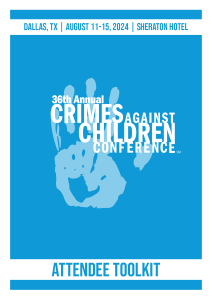Back
Workshop
Sheraton Conference Center - 1st Floor
Strangulation: Beyond the Obvious in Child Abuse
Monday, August 12, 2024
1:45 PM – 3:00 PM CT
Location: Dallas C
Credit Hours: 1.25

Kelsey McKay
JD/Consultant
McKay Training & Consulting, LLC
Andrea Zaferes (she/her/hers)
VP/Consultant
Lifeguard Systems, Inc
Primary Presenter(s)
Co-Presenter(s)
If you don’t know a crime exists, what are the chances it will be identified, investigated or prosecuted? The use of asphyxiation (including strangulation, suffocation and aquatics) abuse against children is more prevalent than currently understood by those who are tasked to identify and investigate allegations of child abuse, sexual violence and homicide. These cases, being largely, if not fully, circumstantial also present challenges to practitioners who cannot rely on external injuries to identify this type of abuse. In these cases, injury is not always obvious and reliance on external signs can misdirect the fate of a case. As a result, asphyxiation cases are underreported, undiagnosed, and misunderstood by the medical and criminal justice system. This workshop will provide all members of the multidisciplinary team including law enforcement, CPS, investigators, forensic interviewers, medical teams and prosecutors with the tools to assess and interview children who have been asphyxiated. With proper training and protocol, practitioners have started to better identify this often missed and lethal crime, finally giving this crime and the victims a voice.
Learning Objectives:
- Identify at least 3 different types of criminal asphyxia
- Identify at least 3 potential symptoms of criminal asphyxia
- Recognize at least 3 at-risk populations of criminal asphyxia

